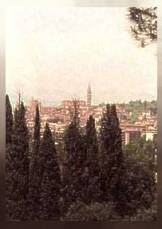Learn Italian -- Live in Tuscany


Arezzo is yellow-gold, rich, deep, sunny, the color of her ancient stucco palazzi and stone monuments. The Aretini are friendly and approachable to us who yearn for a real-life experience in Tuscany. The Centro di Cultura Italiana Arezzo offers the opportunity to learn Italian, or push it to that next level of achievement, in a remarkably personal environment that provides more than mere book learning. I looked for a school where I wouldn't get lost in the mass of students and too-busy teachers. I looked for an off-the-main-tourist-route city, boasting interesting art and history and easy connections to other hill towns and cities in Tuscany and Umbria. I found what I was looking for in Arezzo at the Centro di Cultura Italiana.
The school offers a variety of language courses, depending on size of group and area of focus. The regular Intensive Course, the most cost-effective and popular, offers groups that are small (6-12 students or fewer). The teachers are very professional and accessible, anxious to help make the student's experience a good one. College students as well as adults of every age and background make their way to Arezzo to learn Italian for any number of reasons. Often, merely for the pleasure of it.
The Centro can arrange various types of accommodation. The alternatives are a single or double room with a local family, an apartment with other course participants, an independent apartment or a hotel room.
Besides language classes, the Centro di Cultura Italiana Arezzo's program includes activities designed to involve students in local day to day life. A series of excursions and activities revolves around the area's History and Art, Landscape and Environment, Current Events and Traditions and Politics and Social Life. For instance, some of the excursions might include the medieval churches of the Pievi, the hill town of Cortona, the medieval village of Anghiari, or the Etruscan temple of Pieve at Socana. Visits to the studios of artisans or encounters to discuss politics and social issues with local representatives are also possible. The school organizes social outings, and the evening gathering at a local restaurant is always unforgettable -- for the food and the company.
Arezzo perches on a hill, south and east of Florence, overlooking the Arno and Tiber River valleys. An important Etruscan and Roman city, it was a prosperous independent republic in the Middle Ages until, in 1384, it was subjugated definitively by Florence, and became part of the grand-duchy of the Medici family.
Petrarch and Vasari both came from Arezzo, but it is the fresco cycle of Piero della Francesca in the church of San Francesco that draws the attention of tourists seeking the city’s most glorious Renaissance art. Begun by della Francesca in the 1450's and finished by 1457, The Legend of the True Cross decorates the choir and inspires awe as its current restoration gradually allows the softly brilliant colors and statuesque figures to emerge eloquently into the space.
Arezzo is well connected by train and bus to the rest of Tuscany and to Umbria. Since it is a stop on the main north and south train line between Milan and Rome, travel is very easy. A day in Florence, Siena or Perugia or an afternoon in Cortona offers no problem to the student wanting to venture away from "home."
I lost myself easily in Arezzo's evocative, narrow vicoli, free to imagine the city's Medieval and Renaissance past. I sat and sipped an aperitivo or a caffè more than once at a table under the Loggiato del Vasari in elegant, tilted Piazza Grande or somewhere along bustling Corso Italia, the main shopping strip that is reserved for pedestrians. The Aretini are friendly and Arezzo, though visited by some tourists, is not overrun by them. Art from various periods abounds in the numerous churches and museums and the food and wine is extraordinary. I remember especially well the hearty soups and amazing pasta dishes, the fresh vegetables and sinful desserts.
When I was there in September I found free concerts late on Sunday afternoon in the church of Santa Maria della Pieve, a perfect respite after a long day of walking. Parks and plxenty of green space border the town, not to mention the views that make Tuscany an attractive destination to so many of us.
So, if you are looking for a place in Tuscany to really live while you learn the language and culture, you might consider a sojourn in Arezzo at the Centro di Cultura Italiana.
If you are interested in studying Italian in Arezzo through the Centro Cultura Italiana, please contact the school directly.